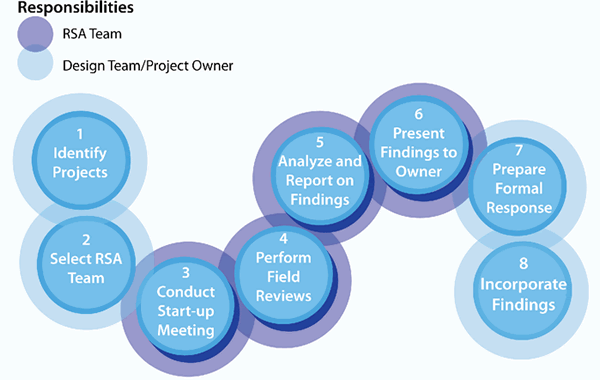Road Safety Audits (RSAs) are an effective tool for proactively improving roadway safety. The Federal Highway Administration (FHWA) defines an RSA as a "formal safety performance evaluation of an existing or future road or intersection by an independent, multidisciplinary team." The primary focus of an RSA is safety, but other aspects, such as mobility, access, surrounding land use, and aesthetics are also considered.
An RSA conducted by a team that is independent of the design and operations of the facility can address safety through a thorough review of roadway, traffic, environmental, and human factors conditions. By using an unbiased and multidisciplinary team to perform a comprehensive review and an evaluation of physical, operational, and human-factors-related safety issues for a given study area, RSAs make sure that safety is adequately considered. The RSA team is typically composed of at least three members having expertise in road safety, traffic operations, and road design. Other potential team members may have a background in (but not limited to) enforcement, emergency medical services, maintenance, human factors analysis, transportation planning, pedestrian safety, and bicyclist safety.
RSAs can be done at any stage in a project’s life:
- A Pre-Construction RSA (planning and design stages) examines a road before it is built. This could occur at the system or project planning, feasibility, or project development stage or could occur during the design state beginning with preliminary design stage and ending with final design stage. An RSA at this stage identifies potential safety issues before crashes occur. The earlier a pre-construction RSA is conducted, the more potential it has to effectively remedy possible safety concerns. For example, a planning stage RSA can examine a system of roads before a specific project has been identified for project development, design, and construction. The transportation system is assessed at this earliest point to identify, assess, prioritize, and program projects and activities that would considerably enhance traveler safety, in the context of and in collaboration with other multimodal transportation investments.
- Construction RSAs(work zone, changes in design during construction, and preopening) examine temporary traffic management plans associated with construction or other roadwork and changes in design during construction. RSAs at this stage can also be conducted when construction is completed but before the roadway is opened to traffic.
- A Post-Construction or Operational RSA (existing road)examines a road that is operating and is usually conducted to address a demonstrated crash problem.

Figure 1: Typical eight-step RSA process.
